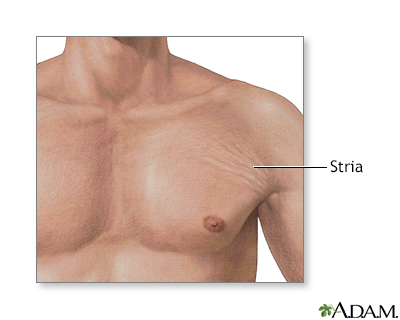Stretch marks
Stretch marks are irregular areas of skin that look like bands, stripes, or lines. Stretch marks are seen when a person grows or gains weight rapidly or has certain diseases or conditions.
The medical name for stretch marks is striae.
Considerations
Stretch marks can appear when there is rapid stretching of the skin. The marks appear as parallel streaks of red, thinned, glossy skin that over time become whitish and scar-like in appearance. Stretch marks may be slightly depressed and have a different texture than normal skin.
They are often seen when a woman's abdomen gets larger during pregnancy. They can be found in children who have become rapidly obese. They may also occur during the rapid growth of puberty. Stretch marks are most commonly located on the breasts, hips, thighs, buttocks, abdomen, and flank.
Causes
Causes of stretch marks may include any of the following:
- Cushing syndrome (disorder that occurs when the body has a high level of the hormone cortisol)
Cushing syndrome
Cushing syndrome is a disorder that occurs when your body has a high level of the hormone cortisol.
 ImageRead Article Now Book Mark Article
ImageRead Article Now Book Mark Article - Ehlers-Danlos syndrome (disorder marked by very stretchy skin that bruises easily)
Ehlers-Danlos syndrome
Ehlers-Danlos syndrome (EDS) is a group of inherited disorders marked by extremely loose joints, very stretchy (hyperelastic) skin that bruises easil...
 ImageRead Article Now Book Mark Article
ImageRead Article Now Book Mark Article - Abnormal collagen formation, or medicines that block collagen formation
- Pregnancy
- Puberty
- Obesity
Obesity
Overweight and obesity mean having a weight than is higher than what is healthy for a given height. A person may be overweight from extra muscle, bo...
 ImageRead Article Now Book Mark Article
ImageRead Article Now Book Mark Article - Overuse of cortisone skin creams
Home Care
There is no specific care for stretch marks. Marks often disappear after the cause of the skin stretching is gone.
Avoiding rapid weight gain helps reduce stretch marks caused by obesity.
Weight gain
Unintentional weight gain is when you gain weight without trying to do so and you are not eating or drinking more.

When to Contact a Medical Professional
If stretch marks appear without a clear cause, such as pregnancy or rapid weight gain, call your health care provider.
What to Expect at Your Office Visit
Your provider will examine you and ask about your symptoms, including:
- Is this the first time that you have developed stretch marks?
- When did you first notice the stretch marks?
- What medicines have you taken?
- Have you used a cortisone skin cream?
- What other symptoms do you have?
If the stretch marks are not caused by normal physical changes, tests may be done. Tretinoin cream may help reduce stretch marks. Laser treatment may also help. In very rare cases, surgery may be done.
Reviewed By
Elika Hoss, MD, Assistant Professor of Dermatology, Mayo Clinic, Scottsdale, AZ. Also reviewed by David C. Dugdale, MD, Medical Director, Brenda Conaway, Editorial Director, and the A.D.A.M. Editorial team.
James WD, Elston DM, Treat JR, Rosenbach MA, Neuhaus IM. Abnormalities of dermal fibrous and elastic tissue. In: James WD, Elston DM, Treat JR, Rosenbach MA, Neuhaus IM, eds. Andrews' Diseases of the Skin. 13th ed. Philadelphia, PA: Elsevier; 2020:chap 25.
Patterson JW. Disorders of collagen. In: Patterson JW, ed. Weedon's Skin Pathology. 5th ed. Philadelphia, PA: Elsevier Limited; 2021:chap 12.



 All rights reserved.
All rights reserved.